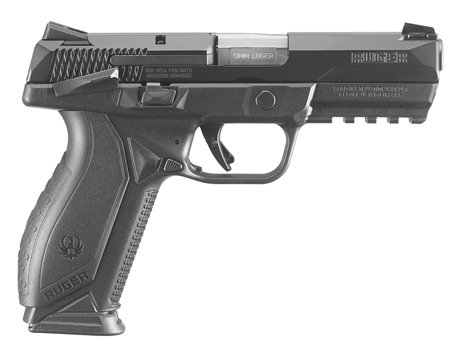
Ruger was hitting on all cylinders at SHOT Show last January, introducing the Ruger American Pistol and the Ruger Precision Rifle to very high praise. Ruger’s American Pistol may have been a little late to the striker-fired, polymer framed pistol competition, but their entry is noteworthy.
Ruger has recently added Ruger American Pistols with an external safety lever. Though external safety levers are not my personal preference for the highly versatile striker-fired format, these new models will prepare the Ruger American Pistol to be purchased by those living in some of the more restrictive States requiring one.
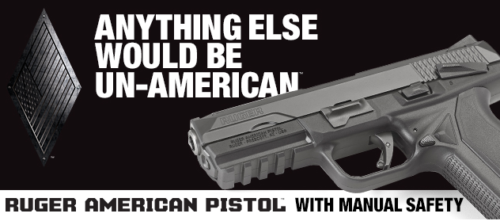
The Ruger American Pistol
A quick look at the Ruger American Pistol (RAP) and the shooter can see inspiration from Glock, Smith & Wesson M&P, Walther, and H&K. Having shot the Ruger American Pistol at SHOT Show I was impressed. The RAP has a balanced feel, manageable recoil, a good trigger, and short reset. Metal magazines, an adjustable grip swell, ambidextrous slide stop lever and magazine release, and nice low profile Novak 3-dot sights are stand out features of this feature-packed pistol.
In fact, the few complaints I had with the Ruger American Pistol, as I noted in my first post, were the very cheap looking metal-injection-molded (MIM) slide stop lever, a slightly too small magazine release, and the 9mm being a little less accurate than I would have liked. Not bad accuracy at all, but it just didn’t group as well as the .45 ACP version.
The new manual safety lever is ambidextrous on the rear portion of the glass-filled nylon frame. That part is great for left-handed shooters, and for transition shooting with strong and support hands.
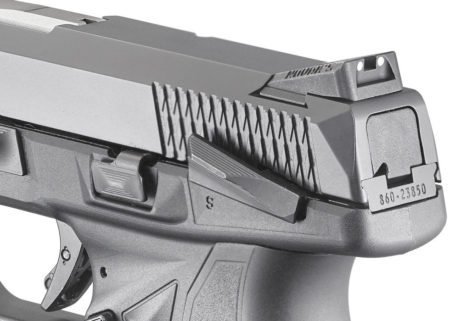
However, I do not like the safety lever design. Similar to the Smith & Wesson M&P pistols with a manual safety lever, the Ruger safety is on when the safety lever is in the up position. This means the shooter must move their thumb above the lever to press the lever down bringing the pistol into the fire position. Surprisingly, earlier S&W pistols with manual safeties had exactly the opposite configuration.
This is unnatural, and could cause significant hindrance in a sudden threat situation, where the shooter wants to get on target and be ready to fire as soon as possible. It’s just one more reason I do not favor manual safety levers. Though Ruger is marketing to those who do prefer these safeties, or to those living in States with restrictive laws requiring them, they should have made the design more natural. A quick upward flip of the thumb to disengage the safety and make the pistol ready to fire would have been more appropriate and ergonomic.
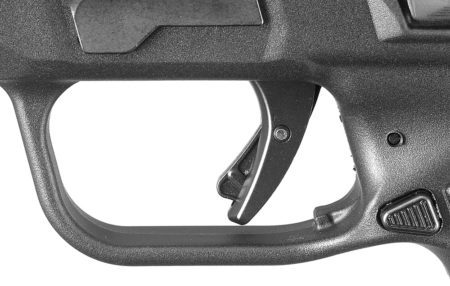
Ruger American Pistol Features
- Trigger features a short takeup with positive reset
- Recoil-reducing barrel cam
- Low mass slide, low center of gravity and low bore axis
- Performance tested for sustained +P ammunition use
- Genuine Novak® LoMount Carry 3-dot sights
- Modular wrap-around grip adjusts palm swell and trigger reach
- Safe, easy takedown with no tools or trigger pull required
- Ambidextrous slide stop and magazine release
- Ambidextrous external safety lever
- Internal, automatic sear block safety system
- Integrated trigger safety (no trigger pull required for takedown)
- (2) nickel-teflon® plated steel magazines
- Small, medium and large grip modules
- Includes hard plastic case.
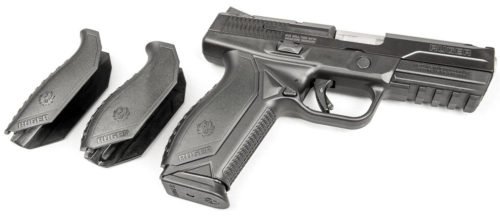
Ruger American Pistol Specifications
- Slide Material: Stainless steel
- Slide Finish: Black nitride
- Frame Material: One-piece, glass filled nylon
- Overall Length: 7.50″
- Barrel Length: 4.20″
- Height: 5.60″
- Overall Width: 1.51″ (original 1.40″)
- Weight 9mm: 31 oz. (unloaded)
- Weight .45 ACP: 32.5 oz. (unloaded)
- Twist Rate: 1:10 RH, 6 grooves
- MSRP: $579.00.
Final Thoughts
As I wrote before, I really like the Ruger American Pistol. It is definitely late to the striker fired pistol market, but Ruger’s late entry does pack a lot of features. The new manual safety is a detractor and poorly designed in my opinion, but it may be required or just what some shooters are looking for.
Mike says
I understand where you’re coming from, but I feel exactly the opposite. Perhaps because of training and competing with 1911s, for me a safety has to move down to bring the gun into firing mode. My thumb swipes downward during my drawstroke, and (as with most of my pistols) if there’s no safety catch there, I’m good to go.
Aaron E says
Mike, I totally agree with your perspective. Though an external safety is not my preference, and if I had one I’d prefer an “up” move to fire, a person with your experience is well prepared to use a pistol like the Ruger American. I’m also a firm believer that any shooter committed to training can learn their firearm to proficiency, though some may be harder than others.
Kevin says
For those who are accustomed to using a manual safety such as found on a 1911 pistol or AR rifle, the downward motion of the thumb is completely natural to disengage a safety. Even when using a Beretta 92 or PX4, the downward swipe of the thumb deactivates the safety. I believe the best pistol designs, especially for non-professionals, are those that allow a round to be chambered and the chamber to be cleared while a safety is engaged.
Ray says
For AIWB carry where I stay (a country with a very high level of petty and violent crime, and where a violent encounter will mean at least 2 or 3 armed attackers) I believe I must carry 1 up there is no alternative and I must have 12 or 15 rounds in the firearm.
I am currently looking at a new pistol and am ruling out all Glocks and guns like the CZ P10 simply as they are not truly safe to carry 1 up appendix carry. This is because there is no way to stop a trigger from being pulled should something get into the holster, as careful as one may be, I admire and applaud the TAU striker control device for the Glock and would consider this, but it is sadly not available in my country.
The Beretta PX4 compact is one option with 15 rounds and a long 1st trigger pull. It is a bit lighter than the Ruger American Compact. I can holster this with the hammer decocked and thumb on hammer, The compact carry is a great choice but also not available as of now in my country. With the compact I would file the levers to make it slimmer and I would make the safety version which I have seen, into a decocker only switch-
this is because the safety on the PX4 is deactivated by a downward thumb movement, unlike the American Compact and the Colt 45 where a downward thumb thrust lets the gun fire,